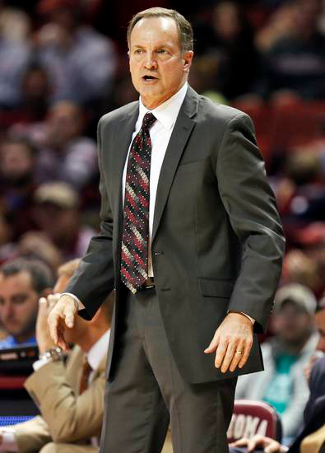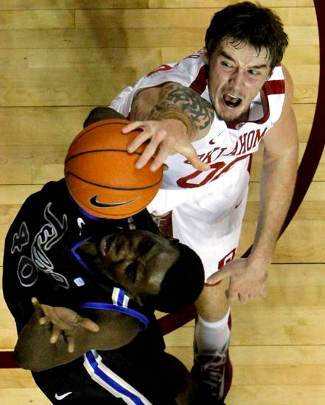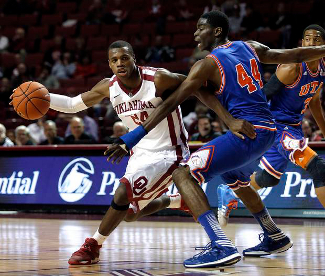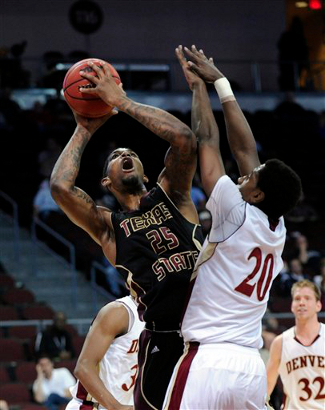The big picture The league’s two preseason favorites both suffered losses over the weekend, but only one will have an impact on the 2014 Big 12 race. Kansas dropped one at home to San Diego State, snapping its non-conference home winning streak at 68 games. With the Jayhawks not opening conference play until their trip to Norman on Wednesday, the early January stumble won’t hurt them as they try to extend their nine-year streak of winning or sharing the Big 12 title. Oklahoma State, however, quickly went off-track in their efforts to break that Jayhawk streak. The Cowboys fell in their league opener at the Octagon of Doom on Saturday, becoming the second big scalp for a Kansas State team that also knocked off Gonzaga in mid-December. While the loss hurt OSU in the standings, their biggest loss of the week came when Michael Cobbins ruptured his left Achilles in a game against Robert Morris. He underwent surgery days later and is out for the year. OSU may have also lost another key piece when Stevie Clark was arrested for marijuana possession on Wednesday. He was previously suspended for four games in late November and December, reportedly also for marijuana issues. Although the Cowboys have one of the nation’s best point guards in Marcus Smart, Clark was averaging more than 16 minutes per game in his nine appearances as Smart’s backup. He did not play in Saturday’s loss to KSU. It’s also worth noting that for the first time in their short Big 12 history, the Mountaineers of West Virginia are over .500 in league play. Last year’s team reached the break-even mark after two, ten, and 12 league games, but could never quite get to a winning record. Weekday games West Virginia at Texas Tech; Monday, 6 P.M. CT (ESPN Full Court/ESPN3) One frequent complaint from Huggins after his team’s move to the Big 12 was the excessive amount of travel required for a school that is essentially marooned from the rest of the conference. West Virginia’s closest conference-mate is Iowa State, which is more than 750 miles away by air. With most of the league even futher away in Kansas, Oklahoma, and Texas, the conference office helped WVU out by scheduling short weekend road swings. After Saturday’s game in Fort Worth, the ‘Eers only had to travel up to Lubbock for tonight’s game, and they will also enjoy a Stillwater-Waco road pairing later in the season. The travel arrangement should — in theory — keep the West Virginia players more fresh by cutting down on the travel fatigue, something that may actually matter against a Texas Tech program that is already making progress under new coach Tubby Smith. For the first time in what seems like eons, the Red Raiders avoided any baffling losses to terrible teams in non-con play and look like they might not be a doormat in the Big 12 this year. Although Tech didn’t pull off any non-conference upsets, the team did take care of business against bottom-feeders, and competed well against LSU in a mid-December home game. Pomeroy calls this one a toss-up, giving West Virginia a 54% chance to win and predicting a one-point game. Baylor at Iowa State; Tuesday, 6 P.M. CT (ESPN2) I don’t have the time to see where this game ranks for the season in terms of tempo disparity, but it’s certainly one that has to be near the top. Iowa State is plugging along at 71.4 adjusted possessions per game, the 39th-quickest pace in D-I hoops to date. Baylor, meanwhile, has been more than content to slow it down while posting a 12-1 mark in non-conference play. The Bears average just 63.3 possessions per game, making them the 13th-slowest squad out of 351 Division I teams. It’s always easier for a slow team to try to impact the pace of a game, but the Bears will still have to overcome Hilton Magic if they want to start their conference campaign with a win. In the two seasons of full round-robin Big 12 play, Iowa State is 16-2 at home. Baylor has also yet to win at Hilton Coliseum since the formation of the Big 12, going 0-10 in Ames. Kansas State at TCU; Tuesday, 7 P.M. CT (Big 12 Network/ESPN Full Court/ESPN3) The Wildcats have certainly turned things around since losing to Northern Colorado in the season opener. Saturday’s win over Oklahoma State was the team’s second victory against a Top 25 in the last three weeks, and it was their ninth-straight win overall. The Wildcats have one of the nation’s stingiest perimeter defenses, limiting opponents to just a 26% success rate behind the arc. That ranks the team fourth-best in Division I, a fact that Oklahoma State can surely attest to after going just 3-for-14 at Bramlage on Saturday. Conveniently enough, Kansas State now faces a TCU team that is coming off its best three-point performance of the year. The Horned Frogs knocked down 9-of-19 from behind the arc in their loss to West Virginia, well above the 33.5% season average they brought into the contest. Kansas State does an excellent job limiting looks by their opponents’ best long-range threats, meaning that freshman swingman Brandon Parrish and point guard Kyan Anderson might not find much room on the perimeter at Daniel-Meyer Coliseum on Tuesday night. Kansas at Oklahoma; Wednesday, 6 P.M. CT (ESPN2) The Sooners have been treated to a brutal five-game stretch to open their Big 12 campaign this year, but they tipped things off with a win in Austin on Saturay night. If Oklahoma can steal a road win against Kansas or Iowa State this week, they will certainly announce their presence as a top-flight team in a very deep Big 12. The Jayhawks are 0-2 in true road games this season, although those losses came against Top 25 competition in Colorado and Florida. Oklahoma managed to pick off KU at Lloyd-Noble last season, so Kansas should be on high alert when they arrive in Norman on Wednesday. The biggest challenge for Kansas will likely be simply keeping pace with the Oklahoma offense. The Jayhawks are coming off of a loss to SDSU in which they posted an eFG of only 25% in the first half and Perry Ellis shot 1-for-8 from the floor. OU’s defense is nothing to write home about, but Kansas still has to get out of their funk on the offensive end if they want to keep up with a Sooner team that has the nation’s 14th-most efficent offense. Texas at Oklahoma State; Wednesday, 8 P.M. CT (ESPNU) LRT’s full preview of the Texas/Oklahoma State game will be available on Wednesday. | |||||||||||||||||||||||||||||||||||||||||||||||||||||||||||||||||||














